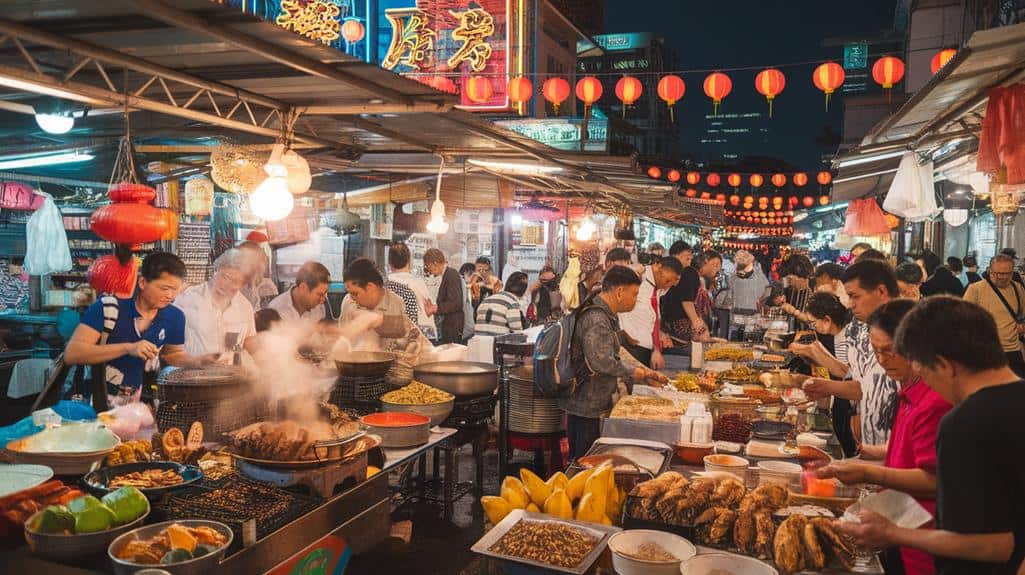
Asia’s Top 10 Street Food Markets: Taste Paradise
Asia's top street food markets offer a tantalizing journey through the continent's diverse culinary landscape. You'll find iconic spots like Taipei's Raohe Night Market, Bangkok's Taling Chan Floating Market, and Seoul's Myeongdong Street Food Alley. These bustling hubs showcase an array of local delicacies, from stinky tofu to pad thai and tteokbokki. Other must-visit markets include Kyoto's Nishiki Market, Kuala Lumpur's Jalan Alor, and Ho Chi Minh City's Ben Thanh Market. Each destination promises unique flavors, aromas, and cultural experiences. As you explore these culinary paradises, you'll discover the heart of Asian cuisine and the rich traditions behind every bite. Uncover the hidden gems and local favorites that make these markets truly exceptional.
In a Nutshell
- Taipei's Raohe and Shilin Night Markets offer iconic Taiwanese street food like stinky tofu and oyster omelets.
- Bangkok's Chatuchak Weekend Market spans 35 acres, featuring diverse Thai street foods and exotic offerings.
- Seoul's Myeongdong Street Food Alley showcases Korean delicacies and innovative fusion creations in a bustling shopping district.
- Kyoto's Nishiki Market presents traditional Japanese ingredients and ready-to-eat delicacies in a historic five-block shopping street.
- Singapore's Chinatown Complex Food Centre houses over 260 stalls, including a Michelin-starred chicken rice vendor.
Raohe Night Market, Taipei
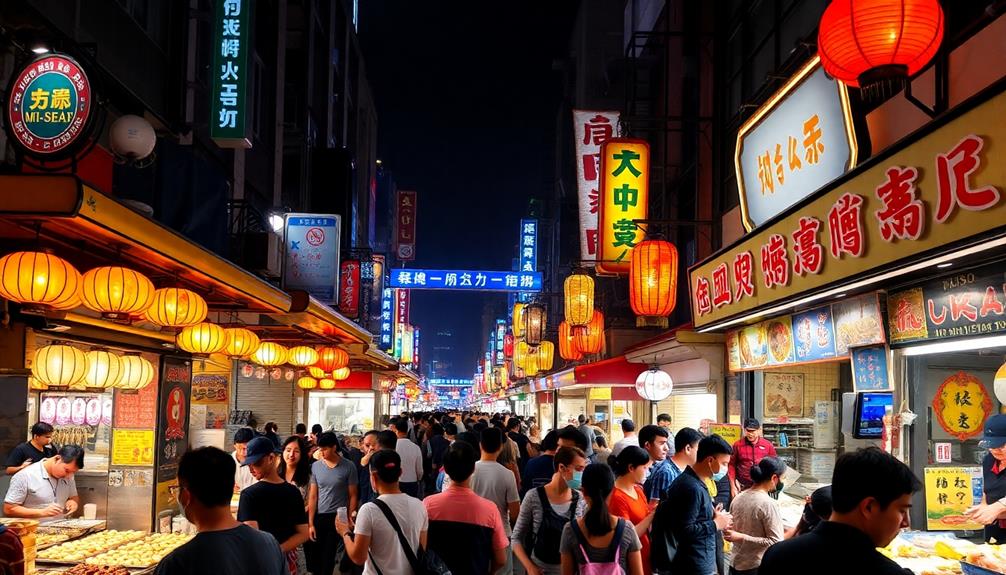
Down in the heart of Taipei, you'll find the bustling Raohe Night Market. This 600-meter stretch, open daily from 5 PM to midnight, offers a sensory overload of sights, sounds, and smells. You'll encounter a diverse array of Taiwanese street food, from the iconic pepper buns to stinky tofu and oyster omelets. The market's entrance, marked by an ornate Chinese arch, leads you into a gastronomic adventure. As you navigate the crowded alleys, you'll discover numerous stalls selling local delicacies, each with its own specialty. To enhance your experience, consider bringing travel accessories like a reusable water bottle and portable cutlery set. Don't miss the opportunity to try the herbal pork bone soup, a local favorite known for its medicinal properties. For dessert, indulge in the sweet potato balls or mango shaved ice. Remember to bring cash, as most vendors don't accept cards. Arrive early to beat the crowds and fully experience this culinary paradise.
Taling Chan Floating Market, Bangkok
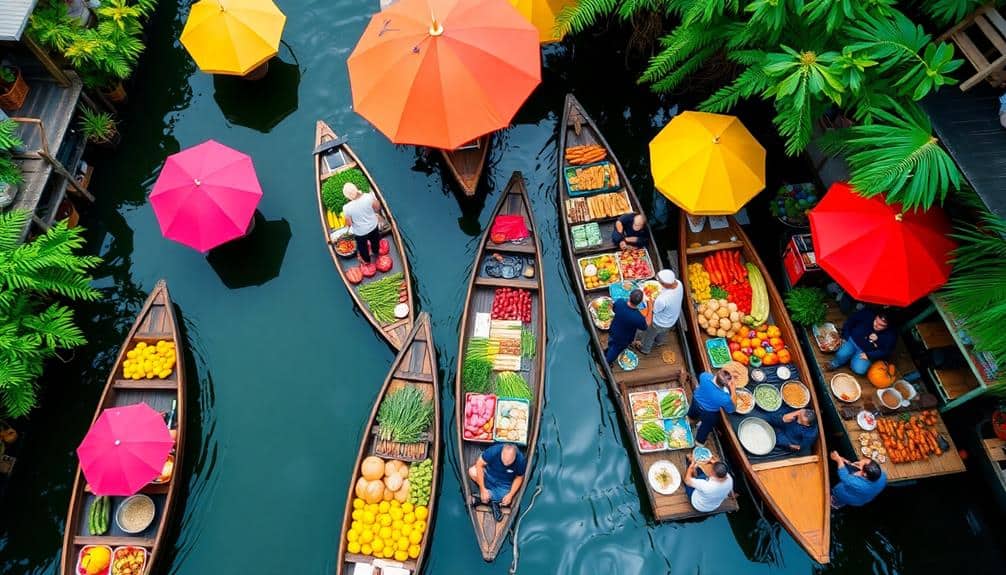
Ever wondered what it's like to shop for food on a boat? At Taling Chan Floating Market in Bangkok, you'll experience this unique culinary adventure firsthand. Located on the outskirts of the city, this authentic market offers a glimpse into traditional Thai waterway culture. As you navigate the narrow canals, you'll encounter a variety of vendors selling fresh produce, local delicacies, and handmade crafts from their wooden boats. After exploring the market, you might want to hang your newly purchased items to dry using a compact travel clothesline perfect for small spaces like hotel rooms or boats.
Key highlights of Taling Chan Floating Market include:
- Fresh seafood grilled on boats
- Traditional Thai sweets and desserts
- Aromatic herbs and spices
- Colorful tropical fruits
- Boat tours of the surrounding canals
The market operates on weekends, from 8 am to 4 pm. To fully immerse yourself in the experience, arrive early and enjoy a leisurely boat ride through the canals before indulging in the diverse array of street food offerings.
Myeongdong Street Food Alley, Seoul
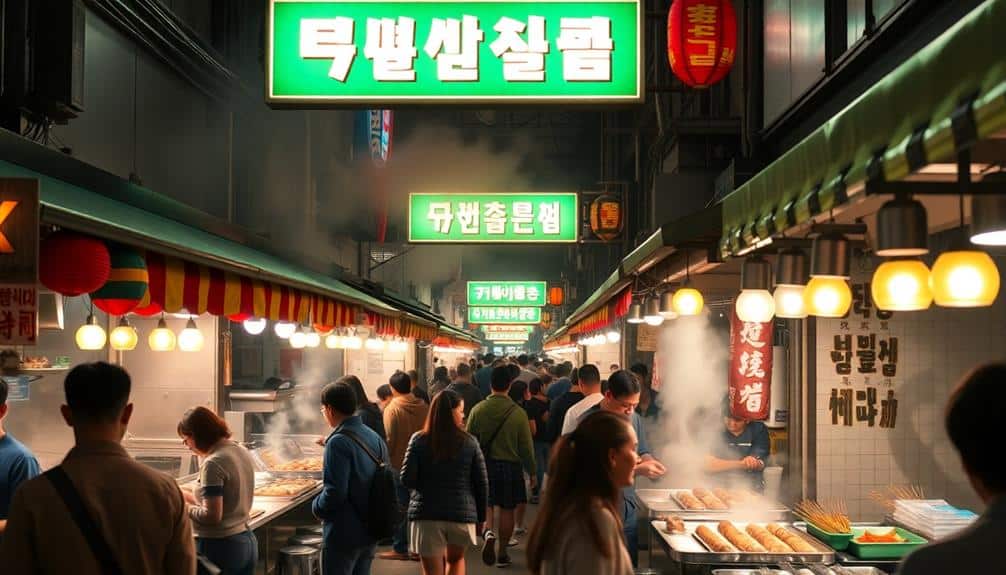
Excitement fills the air as you step into Myeongdong Street Food Alley, Seoul's bustling culinary hotspot. This vibrant thoroughfare, located in the heart of the city's shopping district, offers an unparalleled array of Korean street food delicacies. You'll find vendors skillfully preparing traditional favorites like tteokbokki (spicy rice cakes), odeng (fish cakes), and bindaetteok (mung bean pancakes). Don't miss the opportunity to sample innovative fusion creations, such as the popular cheese-filled hot dogs or the crispy, spiral-cut potato skewers. For travelers who want to keep their clothes fresh while exploring the market, travel laundry bags can be a convenient solution. As you navigate the alley, you'll encounter an assortment of grilled meats, savory pancakes, and sweet treats like hotteok (filled pancakes). The market operates daily from late afternoon until midnight, with peak hours between 8 PM and 10 PM. Be prepared for crowds and bring cash, as most vendors don't accept cards.
Nishiki Market, Kyoto
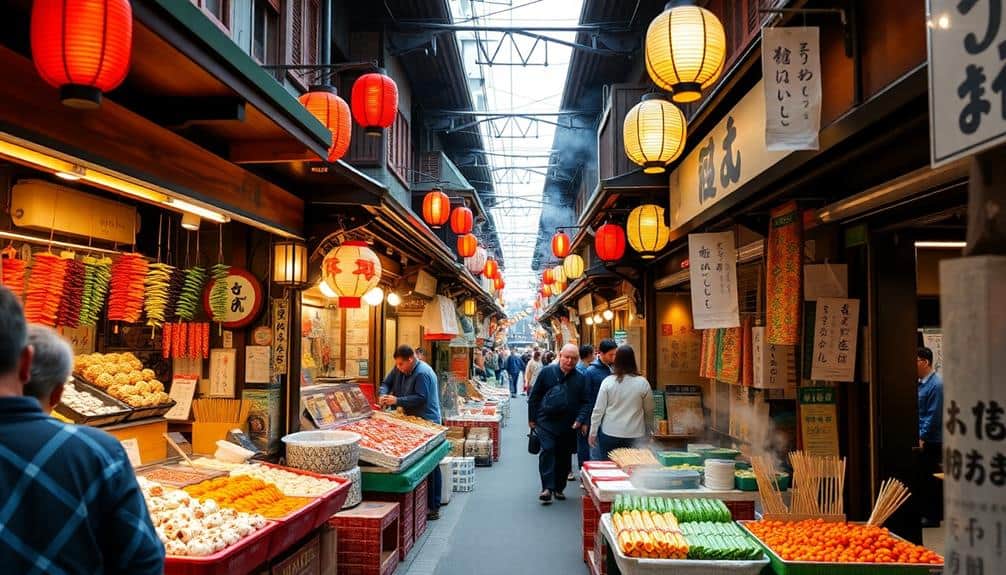
Known as "Kyoto's Kitchen," Nishiki Market is a narrow, five-block long shopping street packed with over 100 shops and food stalls. You'll find an array of traditional Japanese ingredients, local specialties, and ready-to-eat delicacies. The market's history dates back to the 14th century, evolving from a fish market to today's culinary haven.
As you explore Nishiki Market, you'll encounter:
- Fresh seafood, including Kyoto's famous pickled sushi
- Seasonal vegetables and locally grown produce
- Traditional sweets and confectioneries
- Handcrafted kitchen utensils and cookware
- Unique Kyoto specialties like yuba (tofu skin) and tsukemono (pickled vegetables)
The market operates daily from 9 AM to 6 PM, with some stores closing on Wednesdays or Sundays. For the best experience, visit during weekday mornings to avoid crowds and sample the freshest offerings.
Jalan Alor, Kuala Lumpur
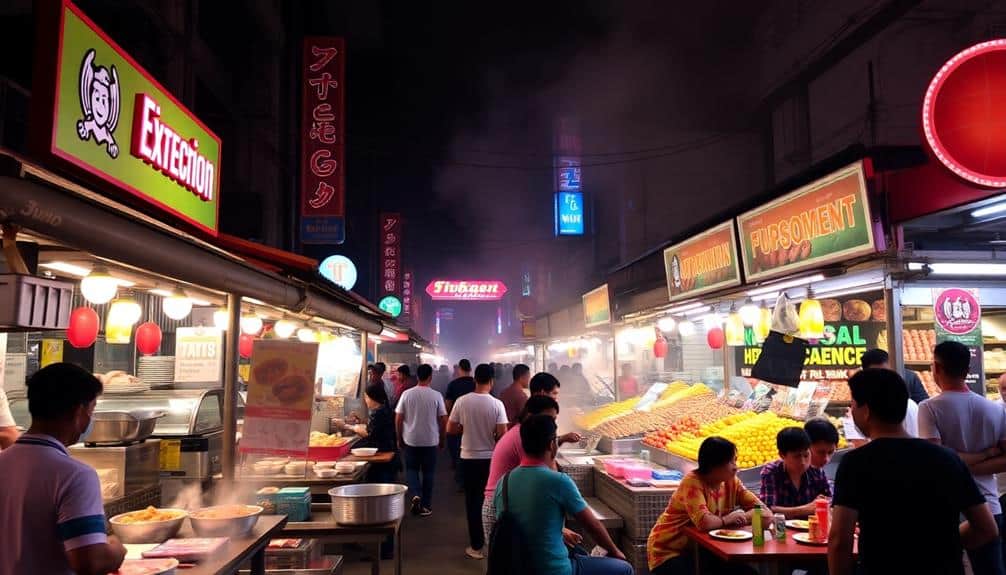
From Japan's traditional markets, we now turn our attention to Malaysia's bustling street food scene. Jalan Alor, located in the heart of Kuala Lumpur, is a culinary hot spot that comes alive after dark. This 1-kilometer stretch transforms into a vibrant food paradise, offering an array of authentic Malaysian dishes and other Asian delicacies. You'll find over 100 hawker stalls and seafood restaurants lining both sides of the street, each specializing in different local favorites. Must-try dishes include satay, char kway teow, and Hokkien mee. The market operates from 5 PM until late, with peak hours between 8 PM and 11 PM. Prices are reasonable, with most dishes ranging from 5 to 15 Malaysian Ringgit. For the best experience, arrive early to secure a table and bring cash, as many vendors don't accept cards.
Shilin Night Market, Taipei
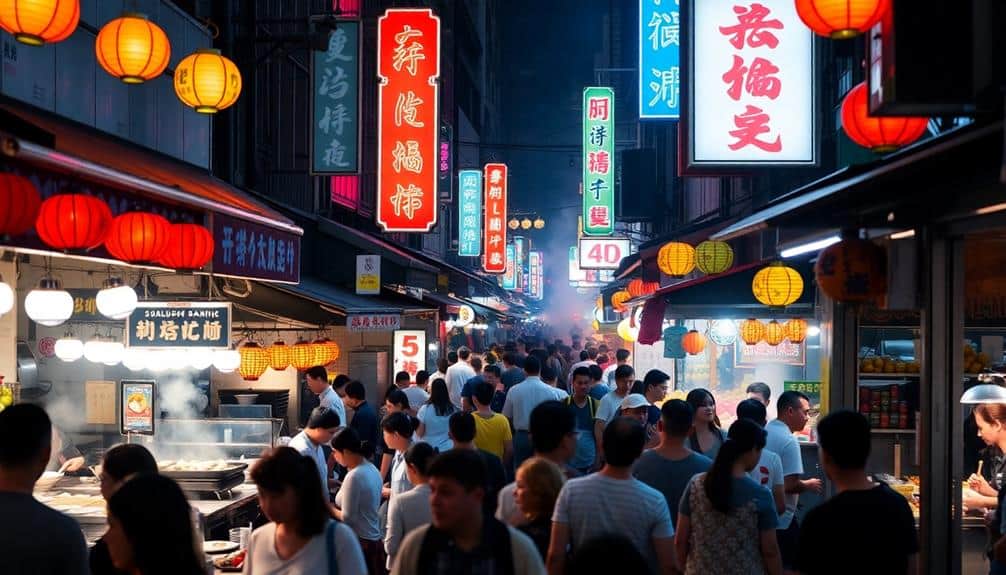
Taiwan's largest and most famous night market, Shilin, is a must-visit destination for food enthusiasts exploring Taipei. Spanning several city blocks, this bustling market comes alive after dark, offering an array of tantalizing local delicacies and street food favorites. As you navigate the maze-like alleys, you'll encounter countless food stalls and vendors, each specializing in unique Taiwanese dishes.
Some of the must-try foods at Shilin Night Market include:
- Stinky tofu, a pungent yet flavorful fermented delicacy
- Oyster omelettes, a savory egg-based dish with fresh seafood
- Bubble tea, the iconic Taiwanese drink with chewy tapioca pearls
- Grilled squid, perfectly seasoned and cooked to tender perfection
- Shaved ice desserts, topped with an all-encompassing assortment of fruits and syrups
Beyond food, Shilin Night Market also features clothing stalls, arcade games, and souvenir shops, making it a multifaceted destination for both culinary and cultural experiences.
Chatuchak Weekend Market, Bangkok
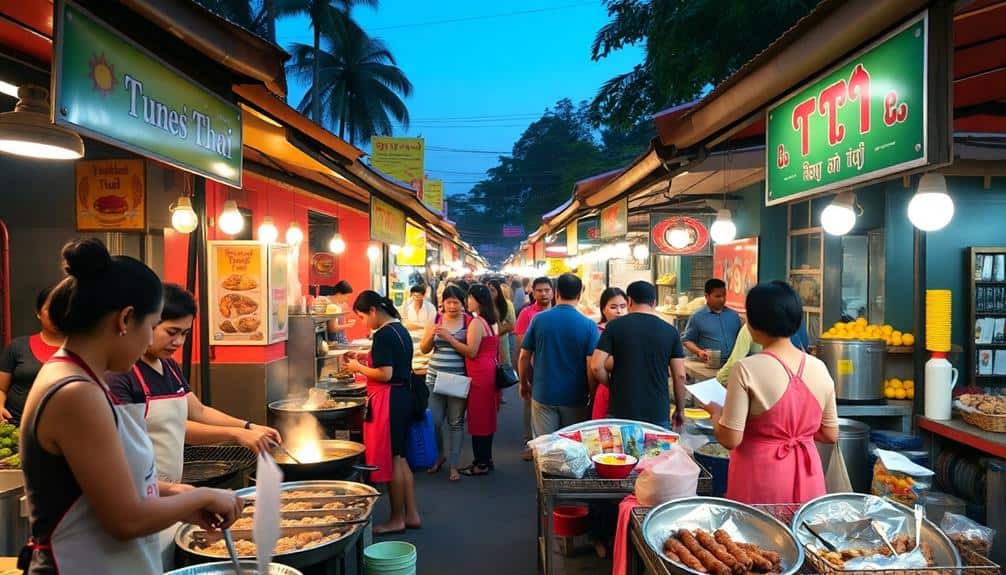
Sprawling across 35 acres, Bangkok's Chatuchak Weekend Market stands as one of the world's largest outdoor markets. You'll find an extensive array of street food options within its labyrinthine lanes, offering a thorough taste of Thai cuisine. Navigate through the bustling aisles to sample local delicacies like pad thai, moo ping (grilled pork skewers), and som tam (green papaya salad). Don't miss the market's renowned coconut ice cream, served in a freshly-cut coconut shell. For the adventurous eater, exotic offerings such as deep-fried insects are available. Be prepared for the heat and crowds, as Chatuchak attracts up to 200,000 visitors each weekend. To beat the rush, arrive early and head to Section 27 for the best food stalls. Bring cash, stay hydrated, and immerse yourself in this culinary paradise that exemplifies Bangkok's vibrant street food culture.
Gwangjang Market, Seoul
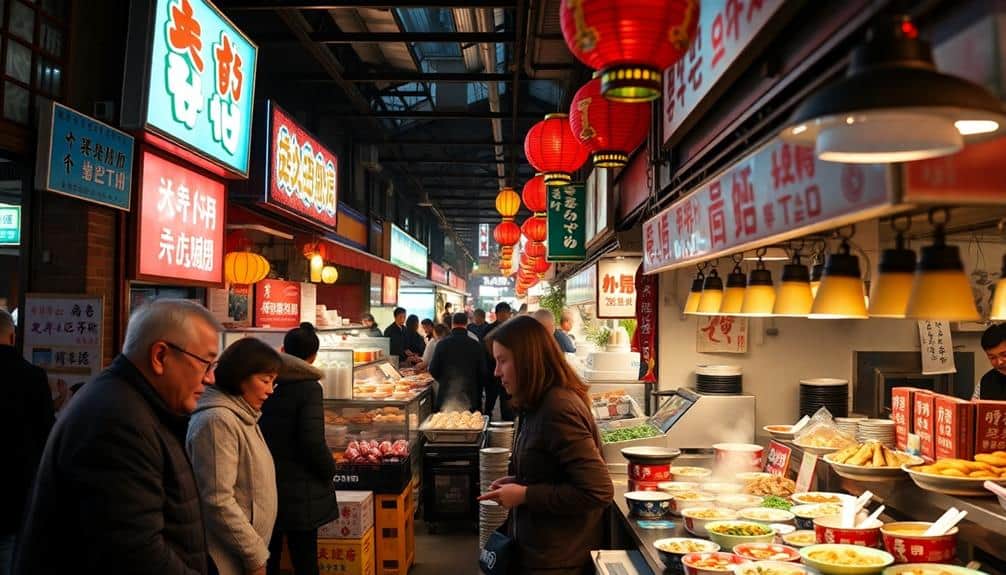
As we shift our focus from Bangkok to Seoul, Gwangjang Market emerges as a culinary hotspot in South Korea's capital. This historic market, established in 1905, offers a diverse array of traditional Korean street foods and local specialties. You'll find yourself immersed in a sensory experience, surrounded by the sights, sounds, and aromas of sizzling delicacies.
Gwangjang Market's must-try dishes include:
- Bindaetteok: Crispy mung bean pancakes
- Bibimbap: Rice bowls topped with vegetables and meat
- Kimbap: Korean-style sushi rolls
- Tteokbokki: Spicy rice cakes in gochujang sauce
- Sundae: Blood sausage stuffed with glass noodles
As you navigate the market's narrow aisles, you'll encounter numerous food stalls, each specializing in specific dishes. The vendors, often elderly women known as "ajummas," have perfected their craft over decades, ensuring an authentic taste of Korean cuisine.
Ben Thanh Market, Ho Chi Minh
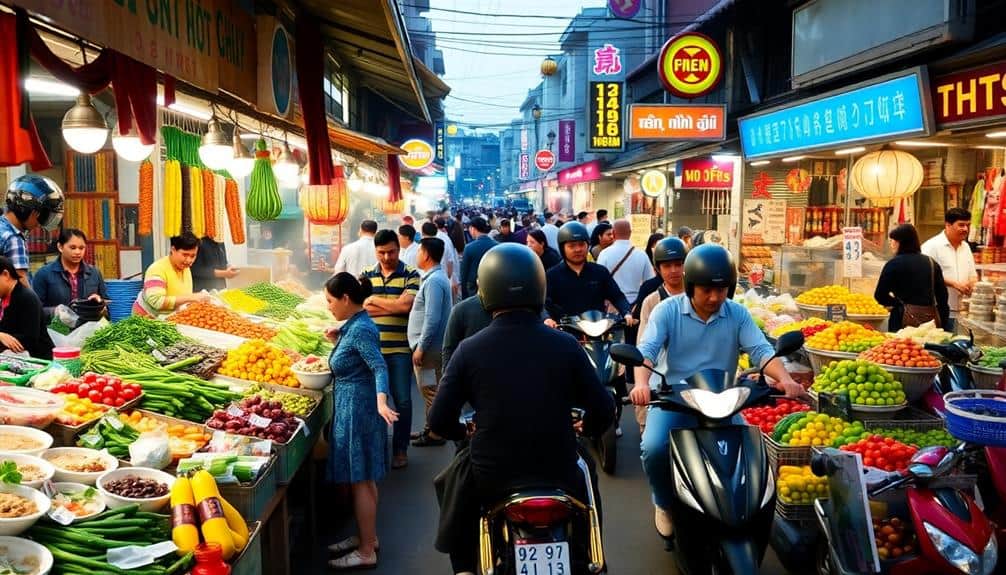
Moving south from Seoul, we find ourselves in the bustling heart of Ho Chi Minh City at Ben Thanh Market. This iconic destination, established in the 17th century, serves as a culinary hub for both locals and tourists. You'll encounter a diverse array of Vietnamese street food, from fragrant pho to crispy banh xeo. The market's labyrinthine aisles house over 3,000 stalls, offering an extensive selection of fresh produce, spices, and prepared dishes. For an authentic experience, visit early morning when locals shop for ingredients. Don't miss the opportunity to sample cao lau, a regional noodle dish, or indulge in fresh spring rolls. Ben Thanh Market's central location, spanning 13,000 square meters, makes it easily accessible. The market operates daily from 6 AM to 6 PM, with a night market running until 10 PM, ensuring ample time to explore its gastronomic offerings.
Chinatown Complex Food Centre, Singapore
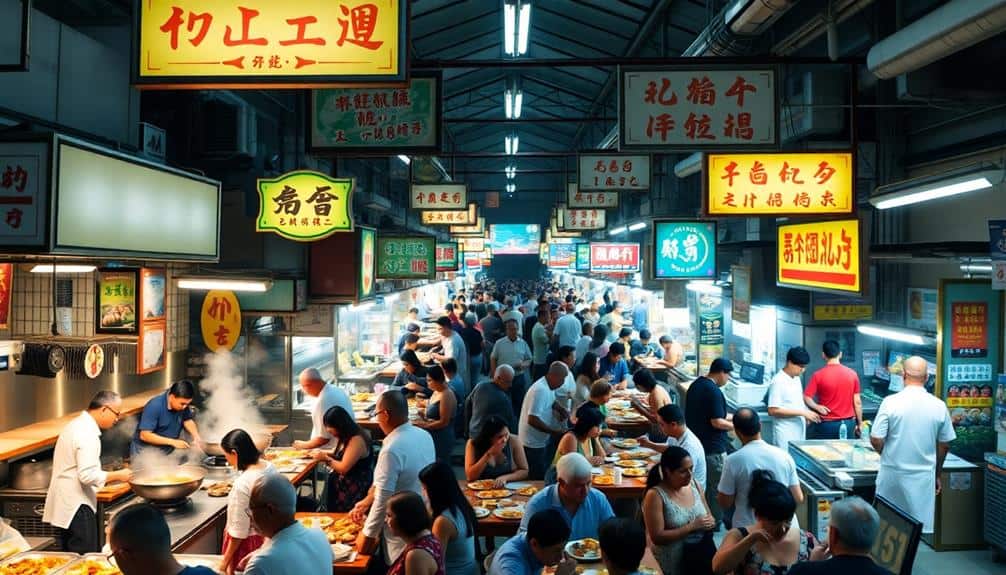
Nestled in the heart of Singapore's vibrant Chinatown, the Chinatown Complex Food Centre stands as a symbol of the city-state's rich culinary heritage. This massive hawker center, housing over 260 food stalls, offers an unparalleled variety of affordable local dishes. You'll find:
- Michelin-starred Liao Fan Hong Kong Soya Sauce Chicken Rice & Noodle
- Traditional Hainanese chicken rice
- Fragrant char kway teow
- Comforting bowls of bak kut teh
- Crispy roti prata with curry
Navigate the bustling aisles to discover hidden gems and long-standing family-run stalls. The center's second floor showcases an impressive array of local and regional cuisines, while the ground level houses a wet market for fresh produce. With its diverse offerings and authentic flavors, Chinatown Complex Food Centre provides an immersive experience into Singapore's multicultural food scene.
Frequently Asked Questions
What Safety Precautions Should Tourists Take When Eating Street Food?
When eating street food, you should take several safety precautions. First, observe the vendor's hygiene practices and cleanliness of their stall. Choose busy stands with high turnover, as food is likely fresher. Opt for hot, freshly cooked items over pre-prepared dishes. Avoid raw or undercooked meats, and be cautious with seafood. Bring hand sanitizer and use it frequently. Stay hydrated with bottled water, and peel fruits yourself. If you have a sensitive stomach, start with small portions to gauge your tolerance.
Are There Vegetarian or Vegan Options Available at These Markets?
Picture yourself strolling through vibrant market stalls, aromatic spices wafting through the air. You'll find that many of these markets offer a surprising array of vegetarian and vegan options. From fresh fruit and vegetable dishes to meat-free versions of local specialties, there's often something for everyone. You'll encounter tofu, tempeh, and plant-based curries in Southeast Asian markets, while Middle Eastern bazaars might feature falafel, hummus, and stuffed grape leaves. It's always wise to inquire about ingredients to verify they meet your dietary needs.
How Do Prices Compare Between Street Food Markets and Regular Restaurants?
You'll generally find that street food markets offer considerably lower prices compared to regular restaurants. The cost savings stem from reduced overhead expenses, such as rent and staff, allowing vendors to keep prices competitive. While quality can vary, you'll often discover exceptional value for money. Keep in mind that prices may fluctuate based on location, ingredients, and demand. It's not uncommon to enjoy a satisfying meal for a fraction of what you'd pay in a sit-down establishment.
What's the Best Time of Day to Visit These Markets?
The best time to visit street food markets depends on your preferences and the specific market's operating hours. Generally, you'll find the freshest offerings and a lively atmosphere during peak meal times: breakfast (7-9 AM), lunch (12-2 PM), and dinner (6-8 PM). However, if you're seeking a less crowded experience, consider visiting during off-peak hours. Some markets come alive at night, offering a unique atmosphere and special dishes only available after dark.
Are English Menus or Translations Commonly Available at These Street Food Markets?
You'll find that English menus or translations aren't consistently available at street food markets. While some vendors in tourist-heavy areas might offer English translations, it's not the norm. You're more likely to encounter local-language menus or no menus at all. To navigate this, consider using translation apps, learning key food-related phrases, or bringing a local guide. Alternatively, you can rely on visual cues, pointing at dishes, or observing what others are ordering to make your selections.
